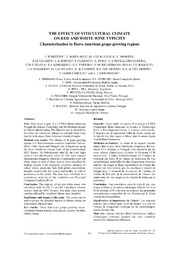The Effect of Viticultural Climate on Red and White Wine Typicity - Characterization in Ibero-American grape-growing regions.
The Effect of Viticultural Climate on Red and White Wine Typicity - Characterization in Ibero-American grape-growing regions.
Autoria: TONIETTO, J.; SOTES RUIZ, V.; ZANUS, M. C.; MONTES, C.; ULIARTE, E. M.; BRUNO, L. A.; CLIMACO, P.; PENA, A.; GUERRA, C. C.; CATANIA, C. D.; KOHLBERG, E. K.; PEREIRA, G. E.; RICARDO-DA-SILVA, J.-M.; RAGOUT, J. V.; NAVARRO, L. V.; LAUREANO, O.; DE CASTRO, R.; DEL MONTE, R. F.; DEL MONTE, S. A.; GOMEZ-MIGUEL, V.; CARBONNEAU, A.
Resumo: Aim: This study is part of a CYTED (Ibero-American Program for Science, Technology and Development) project on vitivinicultural zoning. The objective was to characterize the effect of viticultural climate on red and white wine typicity in the macro Ibero-American viticultural region. Methods and results: The climate of 46 grape-growing regions in 6 Ibero-American countries (Argentina, Bolivia, Brazil, Chile, Spain and Portugal) was characterized using the three viticultural climate index of the Geoviticulture MCC System: the Heliothermal index HI, the Cool Night index CI and the Dryness index DI. The main sensory characteristics frequently observed in representative red and white wines of each of these regions were described by enology experts in the respective countries: intensity of colour, aroma, aroma-ripe fruit, body-palate concentration, alcohol, tannins (for red wines) and acidity as well as persistence on the palate. The data were submitted to a correlation analysis of the variables and Principal Component Analysis (PCA). Conclusion: The typicity of red and white wines was correlated with the HI, CI and DI viticultural climate indexes from the MCC System. The main wine sensory variables affected by viticultural climate were identified. Significance and impact of the study : The results can be used to project the potential impacts of climate change on wine sensory characteristics.
Ano de publicação: 2014
Tipo de publicação: Artigo de periódico
Unidade: Embrapa Uva e Vinho
Observações
1 - Por padrão são exibidas publicações dos últimos 20 anos. Para encontrar publicações mais antigas, configure o filtro ano de publicação, colocando o ano a partir do qual você deseja encontrar publicações. O filtro está na coluna da esquerda na busca acima.
2 - Para ler algumas publicações da Embrapa (apenas as que estão em formato ePub), é necessário ter, no celular ou computador, um desses softwares gratuitos. Sistemas Android: Google Play Livros; IOS: iBooks; Windows e Linux: software Calibre.
Acesse outras publicações
Acesse a Base de Dados da Pesquisa Agropecuária (BDPA) para consultar o acervo completo das bibliotecas da Embrapa.

